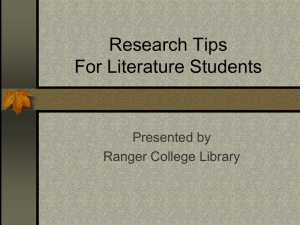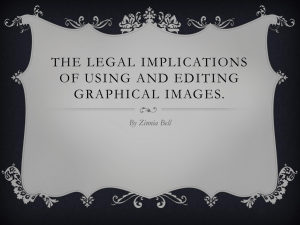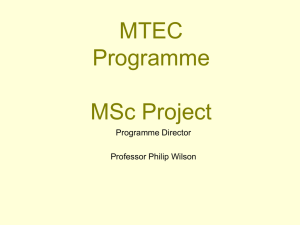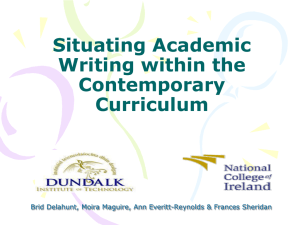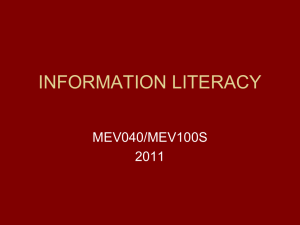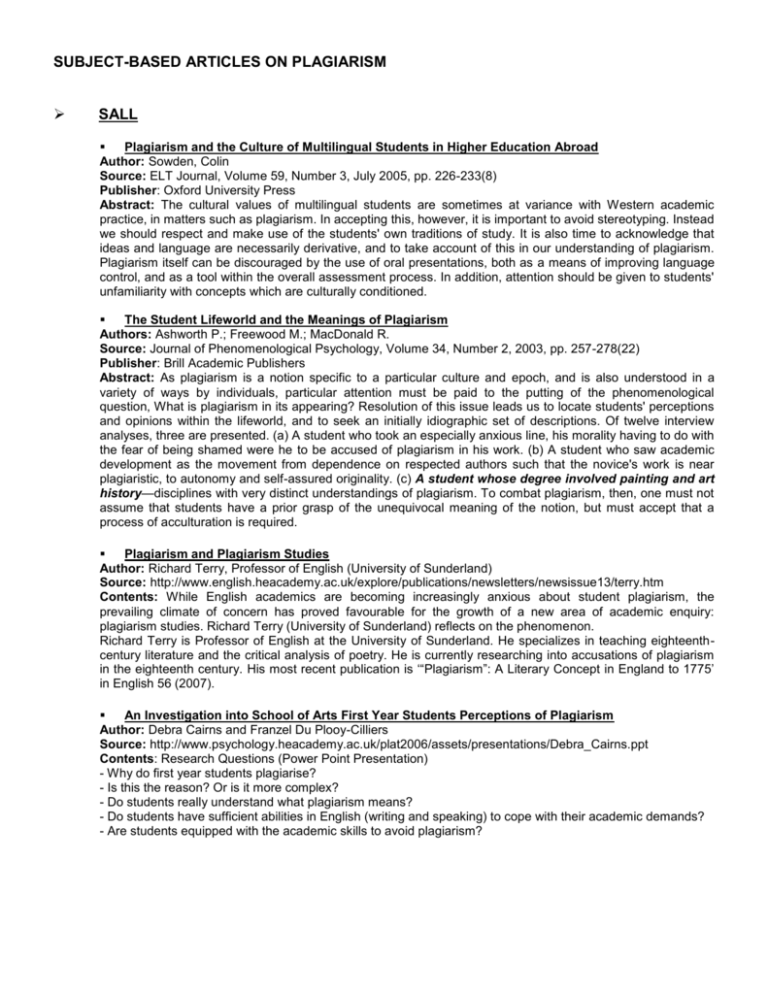
SUBJECT-BASED ARTICLES ON PLAGIARISM
SALL
Plagiarism and the Culture of Multilingual Students in Higher Education Abroad
Author: Sowden, Colin
Source: ELT Journal, Volume 59, Number 3, July 2005, pp. 226-233(8)
Publisher: Oxford University Press
Abstract: The cultural values of multilingual students are sometimes at variance with Western academic
practice, in matters such as plagiarism. In accepting this, however, it is important to avoid stereotyping. Instead
we should respect and make use of the students' own traditions of study. It is also time to acknowledge that
ideas and language are necessarily derivative, and to take account of this in our understanding of plagiarism.
Plagiarism itself can be discouraged by the use of oral presentations, both as a means of improving language
control, and as a tool within the overall assessment process. In addition, attention should be given to students'
unfamiliarity with concepts which are culturally conditioned.
The Student Lifeworld and the Meanings of Plagiarism
Authors: Ashworth P.; Freewood M.; MacDonald R.
Source: Journal of Phenomenological Psychology, Volume 34, Number 2, 2003, pp. 257-278(22)
Publisher: Brill Academic Publishers
Abstract: As plagiarism is a notion specific to a particular culture and epoch, and is also understood in a
variety of ways by individuals, particular attention must be paid to the putting of the phenomenological
question, What is plagiarism in its appearing? Resolution of this issue leads us to locate students' perceptions
and opinions within the lifeworld, and to seek an initially idiographic set of descriptions. Of twelve interview
analyses, three are presented. (a) A student who took an especially anxious line, his morality having to do with
the fear of being shamed were he to be accused of plagiarism in his work. (b) A student who saw academic
development as the movement from dependence on respected authors such that the novice's work is near
plagiaristic, to autonomy and self-assured originality. (c) A student whose degree involved painting and art
history—disciplines with very distinct understandings of plagiarism. To combat plagiarism, then, one must not
assume that students have a prior grasp of the unequivocal meaning of the notion, but must accept that a
process of acculturation is required.
Plagiarism and Plagiarism Studies
Author: Richard Terry, Professor of English (University of Sunderland)
Source: http://www.english.heacademy.ac.uk/explore/publications/newsletters/newsissue13/terry.htm
Contents: While English academics are becoming increasingly anxious about student plagiarism, the
prevailing climate of concern has proved favourable for the growth of a new area of academic enquiry:
plagiarism studies. Richard Terry (University of Sunderland) reflects on the phenomenon.
Richard Terry is Professor of English at the University of Sunderland. He specializes in teaching eighteenthcentury literature and the critical analysis of poetry. He is currently researching into accusations of plagiarism
in the eighteenth century. His most recent publication is ‘“Plagiarism”: A Literary Concept in England to 1775’
in English 56 (2007).
An Investigation into School of Arts First Year Students Perceptions of Plagiarism
Author: Debra Cairns and Franzel Du Plooy-Cilliers
Source: http://www.psychology.heacademy.ac.uk/plat2006/assets/presentations/Debra_Cairns.ppt
Contents: Research Questions (Power Point Presentation)
- Why do first year students plagiarise?
- Is this the reason? Or is it more complex?
- Do students really understand what plagiarism means?
- Do students have sufficient abilities in English (writing and speaking) to cope with their academic demands?
- Are students equipped with the academic skills to avoid plagiarism?
BIOSCIENCES
Tackling Plagiarism in the Level One Biology Class – A Work in Progress
Author: Anne Margaret Tierney, Andrea Brown, Douglas Neil
Source: Practice and Evidence of the Scholarship of Teaching and Learning in Higher Education, Vol 1, No 1
(2006)
Abstract: The Level One Biology class at the University of Glasgow is the largest in Western Europe, with
typically 650-700 full-time undergraduate students. In 2003/04, 23 cases of plagiarism were detected in the
Level One Biology class at the University of Glasgow. Of these cases, the majority (16) cases were “peer
copying”; that is, a pair of students, usually lab partners, doing a piece of coursework outside class, did so by
using one another’s words. The two pieces of near-identical coursework were then handed in, and the
similarities were picked up on marking, either because they were an unusual answer which was wrong, or
correct and worded identically. The other cases consisted of a piece of group work that had been taken from
the internet and “cut and pasted” into a poster, and one final case of an essay that had been copied from the
internet. In response to these cases, each student was interviewed individually. This proved to be timeconsuming and often resulted in an unsatisfactory outcome as it was often impossible to find out who was the
culprit. It was decided that the best course of action was to introduce measures that limited the opportunity to
plagiarise, and to introduce students to the concept of plagiarism and how to avoid it. debate.
SoBE
Ethical Misconduct In The Business School: A Case Of Plagiarism That Turned Bitter
Author: Cabral-Cardoso C.1
Source: Journal of Business Ethics, Volume 49, Number 1, January 2004, pp. 75-89(15)
Publisher: Springer
Abstract: As a result of the public demand for higher ethical standards, business schools are increasingly
taking ethical matters seriously. But their effort has concentrated on teaching business ethics and on students'
ethical behavior. Business faculty, in contrast, has attracted much less attention. This paper explores the
context and the implications of an alleged case of plagiarism in a master's dissertation submitted to a
university lacking both an ethical code of conduct and a formalized procedure to deal with academic
misconduct. The events evolved into a bitter political process in which the more ethically aware members of
faculty challenged efforts to cover-up. Here the focus is on the motives and behavior of faculty members
involved in this case rather than the alleged plagiarist's. The role played by the main actors involved in the
process in examined using the theory of moral development and the organizational politic perspective. The
paper discusses the mechanisms available to raise ethical awareness and prevent academic misconduct, and
the limitations of self-regulation and self-monitoring that prevails in the university system. It also examines the
impact of ethics instruction and faculty ethical standards on students' behavior and concludes that ethics
instruction can only be effective when the principles taught are in line with daily actions of their instructors.
The Efficacy of Policy Statements on Plagiarism: Do They Change Students' Views?
Author: Nitterhouse D.1
Source: Teaching Business Ethics, Volume 7, Number 3, August 2003, pp. 215-227(13)
Publisher: Springer
Abstract: This article addresses the problem of plagiarism in business and business education. It discusses
the issues involved in determining whether plagiarism has actually occurred and a range of alternatives for
preventing, detecting and dealing with plagiarism. The article concludes by discussing the relevance of
plagiarism for businesses students, and suggesting ways that business managers and educators can prevent,
detect, assess and respond to plagiarism in business practice and education.
Plagiarism: Deterrence, Detection and Prevention: The Handbook for Economics Lecturers
Author: Jeremy B. Williams (2005)
Source: HEA website
Contents: 1. Introduction 2.The 'New' Plagiarism - 2.1 The scale of the problem 2.2 The different types of
plagiarism 2.3 Detecting plagiarism 2.4 The motivations for plagiarism 2.5 Deterring and preventing plagiarism
3.Authentic assessment practice - 3.1 Introduction 3.2 Managerial economics Where next? 4.1 Web resources
4.2 Suggested reading
Plagiarism, Computers and Values: Preventing Plagiarism Among International Business and
Management
Author: L D Introna and Anja Timm (Project in progress, 2008)
Source: http://www.heacademy.ac.uk/projects/detail/projectfinder/projects/pf2642
Abstract: The aim of the project is to develop and disseminate the necessary resources to deal with
plagiarism amongst international students in UK post graduate programmes in Business and Management
Studies (BMS) in a progressive and formative manner rather than in the typical reactive and punitive manner.
This will be done by: developing an understanding of different cultural perceptions of plagiarism; understanding
and supporting the writing practices of international students; developing ways to use plagiarism detection
systems in a fair and formative way; and finally, by developing policies and resources for dealing with
plagiarism by international students on an ongoing basis.
SECaM
Plagiarism Prevention and Detection
Author: Georgina Cosma, Mike Joy and Daniel White (updated 2007)
Source: http://www.ics.heacademy.ac.uk/resources/assessment/plagiarism/
Contents: This HEA-ICS resource is aimed at both new and experienced academics seeking information on
plagiarism. It contains:
- A brief guide on plagiarism aimed at new academics.
- Information on dealing with plagiarism. This includes information on how to prevent and detect plagiarism,
information on legal issues, cheat sites and links to institution policies.
- Information about and comparisons between various free-text and source-code plagiarism tools.
- Resources on plagiarism including links to useful plagiarism-related websites, and on-line and off-line papers.
Source code plagiarism in UK HE Computing Schools
Author: Fintan Culwinl, Anna MacLeod and Thomas Lancaster
Source: HEA website: http://www.ics.heacademy.ac.uk/Events/conf2001/papers/Culwin.htm
Abstract: This paper reports upon the results of a survey on the extent of, policy towards and attitudes
concerning source code plagiarism in UK higher education computing schools. The survey was conducted
between Dec 2000 and March 2001 and responses were obtained from approximately half of all schools. It is
intended to continue the survey in an attempt to gain a fuller picture of the situation.
In the autumn of 2000 JISC Committee for Integrated Environments for Learners (JCIEL) [3] commissioned a
number of number of reports into free text (e.g. essay) plagiarism and a single report into constrained text (e.g.
source code) plagiarism [4]. The Center for Interactive Systems Engineering at South Bank University was
commissioned to produce the constrained text report [2]. This paper reports upon the findings of a survey of
UK HE computing schools which formed a substantive part of the report.
SoGAER
Plagiarism: providing strategies to address the issues
Author: Various, From an Engineering Subject Centre Seminar
Source: http://www.engsc.ac.uk/nef/events/plagiarism0506.asp
Overview: The problem of plagiarism by students in both their approach to studying and in their submission of
work has been a topic of escalating concern in recent years. The problem has often been compounded by a
diversity in what is accepted custom and practice across both different disciplines and by different cultures.
Abstract: The aim of this one-day workshop by the Engineering Subject Centre was to stimulate discussion of
possible strategies for detecting plagiarism and for coping with the issues of detected plagiarism. The
workshop provided a forum for teaching staff in engineering to; hear the latest thinking on the assessment of
students’ work, discuss problems and issues that they have experienced in plagiarism by their own students
engage with and learn from exemplars from the excellent community of practice that already exists in these
areas.
Contents: A number of case studies were presented by both teaching academics and educational developers,
that outlined successful approaches that have been used in practice, providing insight and ideas to reflect on
how to eliminate plagiarism with student groups.
Delegates gained a better understanding of the issues in plagiarism – from its occurrence, approaches to its
detection (including by use of appropriate techniques and by software), to strategies for addressing the issues.
The selection of case examples from other disciplines as well as engineering, helped to reinforce this, and
provide a choice of approaches to adopt or adapt back at their home institution
HUSS
Author's Copyright: An Islamic Perspective
Author: Amanullah, Muhammad
Source: The Journal of World Intellectual Property, Volume 9, Number 3, May 2006, pp. 301-315(15)
Publisher: Blackwell Publishing
Abstract: Nowadays, most people have lost their attribute of trustworthiness. Therefore, cheating, harming,
deceiving and neglecting the rights of others have become the order of the day. Among these rights is the
copyright of an author over his own written materials. It is considered to be stealing if someone publishes, in
his own name, materials written by others, or if someone uses materials of others in articles or books without
proper acknowledgement of their authors. However, in order to conduct smoothly the process of learning,
teaching and research, frequently lecturers and students need to photocopy materials written by others, who
have protected their copyright by writing on them “All rights reserved”. When a student needs to prepare a
paper, or a lecturer needs to prepare a lesson or to write a paper or book, sometimes he does not have the
time to write a letter to the relevant authors to receive their permission. On the other hand, if this permission
were sought by thousands of people from a single author or publisher, it would be difficult for him to respond
properly to all of them. The objectives of this article, therefore, are to highlight Islamic rulings for several issues
related to copyright; and to determine how far this copyright should be reserved for the author, and how far a
student or lecturer is allowed Islamically to copy the materials written by others. In order to reach these
objectives, the relevant verses of the Qur'an and ahadith of the Prophet (peace be upon him) and opinions of
Muslim jurists are analytically discussed to find out preferable views in this regard. This article is divided into
the following sections: introduction; whether an author has the right to have monetary compensation for his
work; conditions for the protection of copyright; plagiarism versus permitted quotation; copying or printing a
published book without the permission of its author; and a conclusion.
Evaluating an Electronic Plagiarism Detection Service: The Importance of Trust and the Difficulty
of Proving Students Don't Cheat
Authors: Robert Evans Cardiff School of Social Sciences,Wales
Source: Active Learning in Higher Education, Vol. 7, No. 1, 87-99 (2006)
Publisher: 2006 SAGE Publications
Abstract: Plagiarism by students is seen as an increasing problem. The fear is that students will use the
internet to obtain analysis, interpretation or even complete assignments and then submit these as their own
work. Electronic plagiarism detection services may help to prevent such unfair practice but, in doing so, they
create a new problem: certifying the absence of plagiarism. This article reports the results of an evaluation of
one such service within an interdisciplinary school of social sciences. The article describes how the system
works and the experiences of staff and students in using the service, together with an evaluation of the data
generated. The key findings are that the service did identify examples of poor scholarship and unfair practice
that had been missed under the usual marking system but that rigorously checking every script for plagiarism
was impractical. Trust and student honesty thus remain central to a successful academic system.
Plagiarism in Philosophy: Prevention Better than Cure
Authors: George MacDonald Ross (2003)
Source: HEA website
Contents: While we do expect philosophy undergraduates to think for themselves, we do not expect them to
come up with ideas no one has ever thought of before. Even at PhD level, most universities have abandoned
or at least diluted the originality requirement, given the difficulty of finding something absolutely new to say…
In short, what we are looking for is not original, but independent thinking — and this distinction needs to be
made clear to students.
LAW
Plagiarism: a Guide for Law Lecturers
Author: Alison Bone, University of Brighton
Source: http://www.ukcle.ac.uk/resources/trns/plagiarism/index.html
Contents: This teaching resource note provides basic information on the nature of plagiarism and how to
prevent it, supplemented by extracts from the University of Brighton's student guide on plagiarism.
Abstract: There has been much recent publicity regarding plagiarism - for example, a special report for BBC
Radio 4's PM programme uncovered an "extraordinary level of plagiarism in British universities". There
appears to be general consensus that its incidence is growing, either in real terms or because the perpetrators
are being caught more frequently. This short guide is intended to provide basic information on the nature of
plagiarism, who does it and why - but its prime purpose is to enable lecturers to have an informed discussion
about the best way to prevent it.
Although there is a general consensus reached through research about the causes of plagiarism, it is also
thought that subject groups are best able to tackle it effectively - ie there is a slant to the problem best dealt
with by, in this case, the law teacher.
Guidance to BVC Providers: A Common Approach to Plagiarism and Collusion
Author: EDUCATION AND TRAINING COMMITTEE BVC BOARD
Source: http://www.ukcle.ac.uk/resources/plagiarism/index.html
Purpose: 1.This paper aims to set out a common approach to be adopted by all BVC providers when dealing
with cases of plagiarism and collusion, the principles, procedures and penalties pertaining to such cases and
the relationship between the provider and the student’s Inn in reporting such matters and in determining
whether or not an offending student should be refused call.
SSHS
Assesment Centre Stage
Author: Learning Teaching Support Network, Hospitatility, Leisure, Sport and Tourism
Source: http://www.psychology.heacademy.ac.uk/docs/pdf/p20030613_link_5_pdf0.pdf
Contents: An article including information and advice on:
Using Assessment to Deter Plagiarism; Formative Feedback; Student Groupwork as Real: Live Research;
Examinations Assessed!; Diversity in Assessment; Developing & Applying Assessment Criteria in Sport.
“…Here, the focus is on suggestions about what you assess and how you manage the assessment process to
lessen plagiarism. Usually, success arises from several factors. One lecturer, asked to explain their low
plagiarism rates cited “drumming away at the need to reference”, good written guidance and asking students to
write assignments linked to their practice which, because it is often observed by tutors, can easily be cross
checked, plus using peer assessment so they spot each other’s plagiarism. Another started by insisting that
tutors set new assessment tasks every year. If you want to put together a range of actions around assessment
to lessen plagiarism, you could try any or all of the following suggestions….”
MEDICAL
The Construction of Plagiarism in a School of Nursing
Authors: Paterson B.; Taylor L.1; Usick B.2
Source: Learning in Health and Social Care, Volume 2, Number 3, September 2003, pp. 147-158(12)
Publisher: Blackwell Publishing
Abstract: Despite clear policies for handling reported occurrences of plagiarism, and the inclusion of
antiplagiarism statements in course syllabi and university calendars, reports of both student and faculty
plagiarism in universities has increased dramatically in the past decade. Critics indicate that current
approaches to prevent plagiarism in universities are limited by their focus on the individual and by their failure
to consider the contextual influences in university settings. Eight faculty members and 10 students in a
university school of nursing were interviewed about their understanding of, and response to, plagiarism. The
participants viewed plagiarism primarily as a student problem caused by moral breakdown or ignorance.
Faculty indicated that they most often overlooked university policy for reporting plagiarism if the offence was
deemed as unintentional or caused by personal stress. Students were aware that plagiarism was wrong, but
undergraduate students frequently conceptualized it as an ‘academic quirk’. The article concludes with a
discussion of the implications of the research findings to university schools of nursing.
Exploring Perceptions and Attitudes of Senior Medical Students and Interns to Academic Integrity
Authors: Elzubeir M.A.1; Rizk D.E.E.2
Source: Medical Education, Volume 37, Number 7, July 2003, pp. 589-596(8)
Publisher: Blackwell Publishing
Context: Academic integrity is fundamental to the role of aspiring doctors. However, little is known about
Middle Eastern students' perceptions and experiences of educational dishonesty.
Purpose: To describe the self-reported attitudes and behaviors of senior medical students and interns
regarding educational integrity and to determine whether there are any differences according to gender and
year of study.
Design: Cross-sectional study using a self-administered questionnaire to 88 participants. Setting Faculty of
Medicine and Health Sciences, United Arab Emirates University, Al-Ain, UAE.
Results: A total of 82 (93•2%) respondents considered educational misconduct to be wrong. A total of 78
(88•6%) participants would not engage in such activities. Unethical educational practices such as plagiarism
were viewed less seriously than other aspects of educational misconduct such as misuse of power. Female
students were significantly less likely than males to report that they would engage in dishonest educational
practices (P = 0•04). Interns were more stringent than medical students regarding penalties appropriate for
academic misconduct (P = 0•002). Only 13 (15%) subjects stated that they would inform faculty of dishonest
behavior on the part of their peers.
Conclusion: Most participants, particularly females and interns, consider educational misconduct to be wrong
and would not engage in such activities.
PHYSICS
‘Revision bingo’, plagiarism spotting and teaching ethics in bio-medicine help lecturer gain
national accolade.
Author: Dr Willmott
Source: http://www2.le.ac.uk/ebulletin/news/press-releases/2000-2009/2005/06/nparticle-nh7-28h-rbd
Contents: “Among the numerous examples of Dr Willmott’s commitment to teaching is his invention of a novel
activity on plagiarism. The exercise, in which students are presented with an original text and seven
derivations in order to learn about appropriate and inappropriate uses of source materials, has had an
international impact.
He has also initiated a course on web authoring and bioethics, encouraging students to engage in the ethical
issues related with biomedicine. This represents one aspect of his national involvement in the development of
teaching resources and methodology in the growing field of bioethics. His work at Leicester has helped
students to see that ethics is not an abstract subject, but is rather something in which they are actually
engaged on a daily basis.”
PSYCHOLOGY
The management of academic dishonesty: A survey of practice in UK
Author: G. Dunbar (2005) (HE Academy Psychology Network)
Source: http://www.psychology.heacademy.ac.uk/docs/pdf/p20050426_AcademicDishonestyReport.pdf
Abstract: Dishonesty has always existed, and surely always will. This report examines the way academics
deal with dishonesty by their students. Such dishonesty often takes the form of presenting someone else’s
work as if it was the student’s own, and in this form it is called plagiarism. It can, of course, take many forms.
We will first examine the extent and causes of the problem using information from the growing literature on this
subject, which will lead us to a number of questions. In the second part of the report, we examine the results
from a survey of practice in psychology departments in the UK.
Student Authorship project
Author: James Elander, Gail Pittam, Pauline Fox, Jo Lusher, Kathy Harrington, Nicky Payne
Source: http://www.writenow.ac.uk/student_authorship.html Centre for Excellence in Teaching and Learning
Contents: The Student Authorship project is an initiative to develop and evaluate teaching on ‘authorship’ in
psychology. It is funded through the Higher Education Academy Psychology Network under the Departmental
teaching Enhancement Scheme, and the project is taking place in the psychology departments of Thames
Valley, London Metropolitan, and Middlesex Universities.
The project aims to address the growing problem of unintentional plagiarism, which occurs when students rely
so heavily on their sources – websites, text books or journal articles – that they put themselves at risk of being
accused of plagiarism, because such large portions of their written work consist of unoriginal material pasted
from the web or copied from other sources.


